|
Dec 3 – Sat. We fly from Quito to Baltra on the Galapagos Islands.
Ironically, our coach seats on Aero Gal were far more comfortable, the service
better and the plane better equipped than either of our Continental/United
flights. We stop in Guayaquil on the way and arrive in Baltra for our short bus
ride to the boat dock. Our boat is the Eclipse. There is a group of 40 + people
so it takes time to get them checked in and baggage secured. We have lunch on
the boat and find our way to our respective cabins.
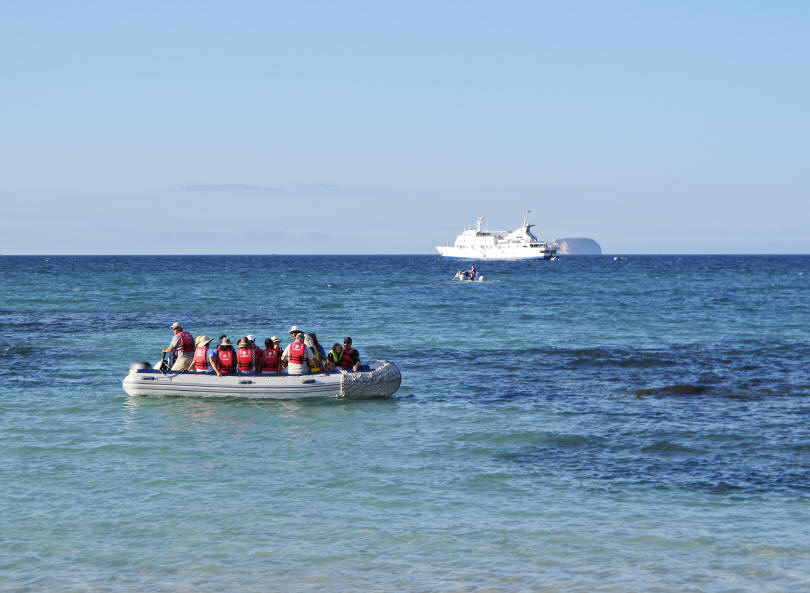
The Galapagos Islands inhospitable to those very first visitors was introduced
to a major part of the then existing population by Charles Darwin based on his
1835 trip on the HMS Beagle about which he published The Origin of Species in
1859. He wrote about the isolated islands, their lack of water, limited human
inhabitants, and untouched, untainted species of all types living on this
volcanic land.
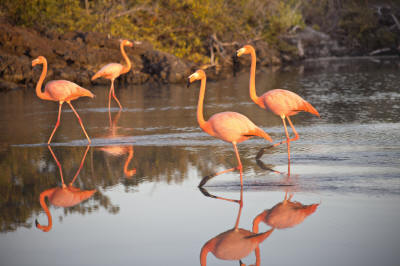 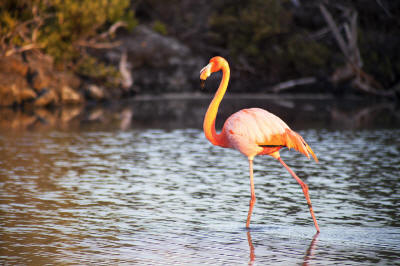
We are briefed about park regulations and ship rules and then are turned loose
for 1/2 hour to prepare for our first island excursion, Las Bachas Beach, Santa
Cruz. A wet landing, feet get wet on sandy beach where we explore sightings of
pink flamingos, marine iguanas, frigatebirds, and sally lightfoot crabs.
Evidence of green sea turtle nesting is prominent.
Dec 4 - Sun – The day starts cloudy and by
noon it is sunny and windy. Our first excursion from the
Eclipse is to Santiago Island at Puerto Egas. The black sandy beach gives way to
an arid overland path as we walk to the lava fields on the coast. Here we smell
sea lions and see armies of marine iguanas lined up waiting for the sunshine to
warm them. As we move on, the Galapagos sea lions take over our attention. It is
pupping season and there are baby sea lions of all ages and sizes with and
without the attention of their moms. We spend quite awhile watching the antics
of three pups, 2 male(2 belly buttons) and 1 female. The fatter of the 3 and a
male picked on the other 2 nonstop while we sit watching arms length away.
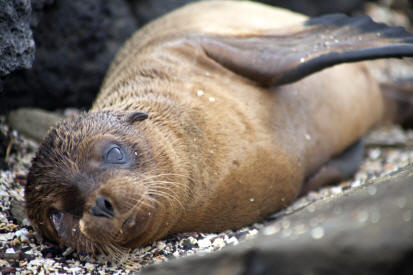 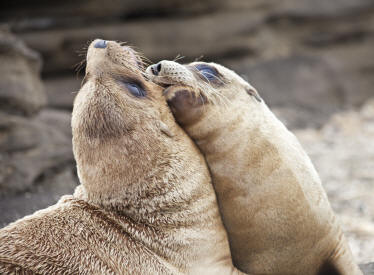
Further down the coast we encounter endless numbers of sally lightfoot crabs
darting in and out of the holes in the black lava rock. The bird population is
equally diversified. We watch a couple of American oystercatchers changing the
guard on a nest of 3 eggs. There are whimbrels, turnstones, plowvers, pelicans
and a blue heron. As we approach the lava grottos, a male Galapagos fur seal
performs a diving feat into a water hole. On our return walk we are introduced
to the Galapagos hawk.
The remainder of the morning we spent snorkeling in the bay. The Pacific sea
turtles showed off for us while we moved along the rocky underwater ridge. As
the wind kicked up, it became colder and harder to maneuver the waves.
While we enjoy lunch we move to Bartolome Island. The wind has kicked up so
Jon elects to do the Rambo snorkeling and Care does the Mickey Mouse snorkel in
the bay. We both see lots of marine life including a lone shark. Later in the
afternoon, we make a dry landing around the other side of the island and take a
30 minute (300 +) step hike across the lava moonscape. We note both the ropey
pahoehoe lava and the a’a sticky fast cooling lava surrounding chutes and tubes
visible on our climb. The view from the top is rewarded by a view of Pinnacle
Rock; Santiago Island in the background.
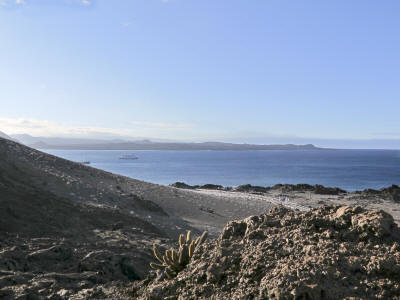 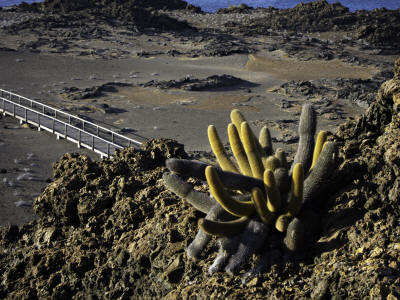
Dec 5 – Mon. We start our Monday morning with a cup of java and a hike on
Santa Cruz Island in the Cerro Dragon area. We notice blue booby birds following
the boat on our way to the island. We look for land iguanas, a yellow, orangish
iguana adapted to the underbrush of this dry volcanic landscape. While we saw
only 2 land iguanas, there is evidence of the presence of wild cats and donkeys.
Volcanic rocks are sprinkled throughout the trail with several brackish lakes in
various stages of evaporation. No flamingos sightings this time but lots of
crabs and sea lions on the shore.
The crew used the travel time to teach us how to make cerviche. With fresh
tuna, it was a real treat.
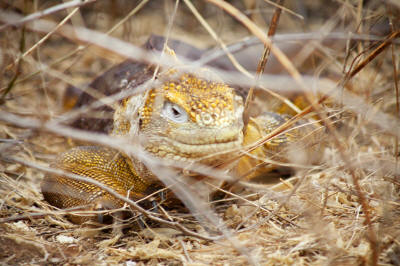 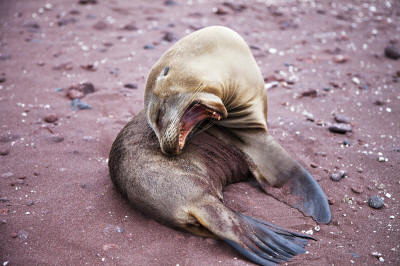
In the afternoon,we arrive on the island of Rabida. Jon and I went snorkeling
and enjoyed swimming with the sea lions, turtles, iguanas and peguins. It was
quite brisk after about 30 mins in the water. We spent some time on another
beach on Rabida walking among the baby seal lions and the bachelor sea lions.
There is also an inland lake where flamingos gather; however we did not see any
during our brief stay.
Dec 6 – Tues. Overnight we cruised over to the west side of Isabela
Island, the largest in the Galapagos archipelago. We woke to a beautiful clear
morning for the grand triathlon of excursions. At 6:00 AM, we prepared for our
speed hike up the Tagus Cove to view Darwin Lake and higher in order to see 3 of
the five major volcanos on the island: Wolf (head of the sea horse), Darwin and
Alcedo. The first several hundred feet up the gully is inhabited by flightless
cormorants, boobies and a sea lion den up on the higher rocks. The red volcanic
rocks have had years to break down to a light layer of soil.
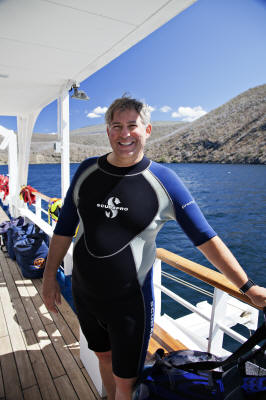
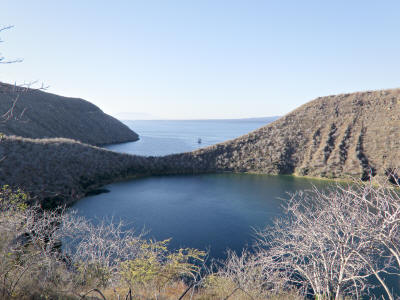
The second event was an hour kayak trip around Tagus Cove. It was a beautiful
morning and the water was fairly calm. We first spotted a pair of sea turtles
mating in the water. Peguins and boobies were spotted on land and in the water.
The last event of the morning was snorkeling in which Jon checked off his
list. They saw so many sea turtles and they became ordinary. The sea lions
whizzed back and forth between the snorkelers. The penguins, iguanas and boobies
watched the swimmers and must have been laughing at the graceless water foul
(sic) in their grotto.
When we pulled up anchor and motored out of Tagus Cove, several whales joined
us to frolic in the warm sunshine. We spend the mid-afternoon moving toward
Elizabeth Bay.
The afternoon we move north to Elizabeth Bay. Here we are restricted to
access via a panga ride. It was a peaceful drift among the mangroves channels
where turtles, penguins and cormorants move in and out of the area.
Dec 7 – Wed. We awake parked off shore of Fernandina Island at Punta
Espinosa. It is the western most island and the youngest. Opposite Tagus Cove,
we land at Punta Espinosa where there supposedly has been no non-native species
introduced to the island. Here, the largest colony of marine iguanas live in the
Galapagos. Sea lions travel from other islands and stay never to return home due
to the plentiful food supply.
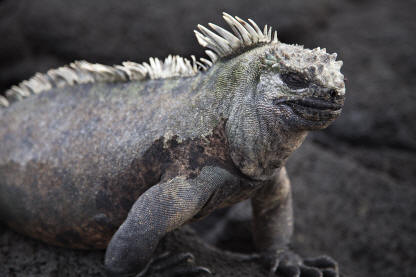 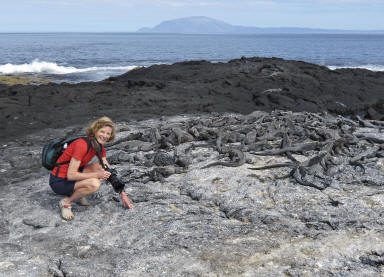
The pohepohe lava covers the landscape although softened by years of
weathering. In a mangrove inlet, we stop to watch a group of 8-10 sea turtles
lounging with a sea lion. We catch the small lizards grooming the iguanas and
sea lions while the cormorants share the rocks with the sally crabs.
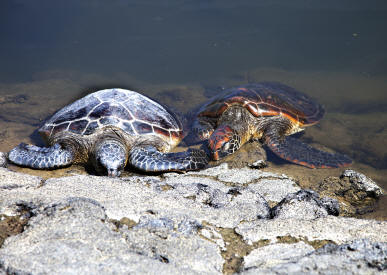
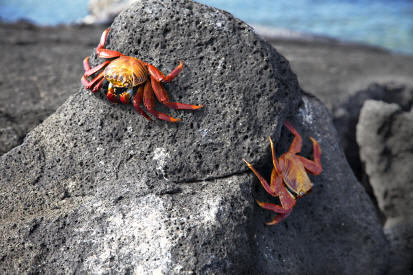
After lunch we motor across the water to Isabela at Punte Vicente Roca where we
anchor for another snorkeling adventure and panga ride. The snorkelers saw lots
of turtles and rays but visibility was more limited today. The high cliffs along
the shore is home to blue footed boobies and pelicans. A few sea lions played
around us. We leave this area and head north to cross the equator for the 3 time
this trip.
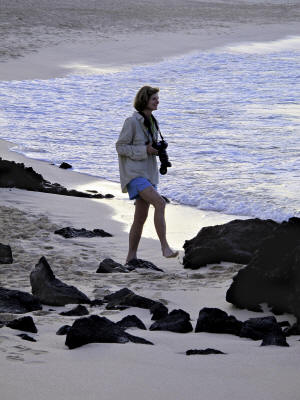 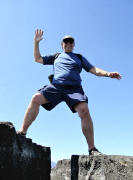
Dec 8 - Thur. We spent the night rocking and
rolling on the ship and were rousted out of bed by 6 AM. Although we were
disembarking at 6:45 our luggage had to be out in the hall by 7 AM. We took the
panga into Puerto Arroyo where we were wisked away in truck taxis to the Charles
Darwin Research Station on the Santa Cruz Island. This is the site of the
research of the development of the tortoises found in the islands and serves as
a breeding center for the park service and private foundations to support the
breeding only by same species. The center is completely outdoors with all ages
of tortoises cared for in native type environments. The babies are penned for
1-5 years to protect them from larger predators.
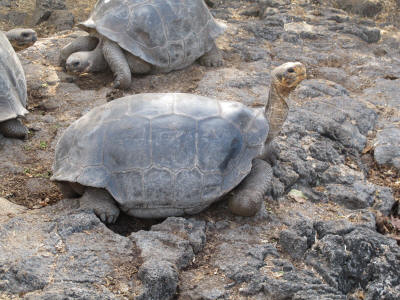 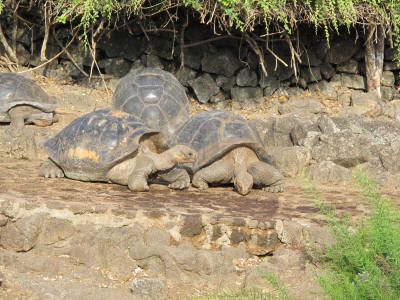
We make about 1 1/2 hour road trip northeast to the edge of the island. There we
catch a boat ferry across a small cove in which we had embarked our first day.
Buses were waiting to take us on to the airport. Our flight lands in Quayaquil
around noon and we settle in at the airport Hilton.
On To Peru -Sacred
Valley
|